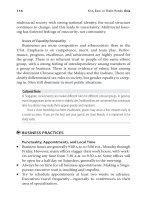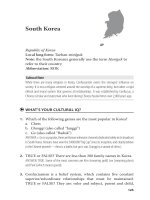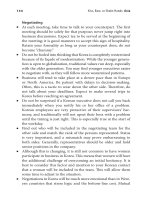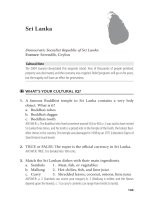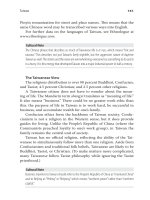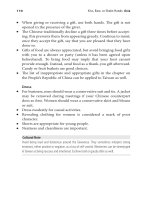How to Do Business in 12 Asian Countries 20
Bạn đang xem bản rút gọn của tài liệu. Xem và tải ngay bản đầy đủ của tài liệu tại đây (123.36 KB, 9 trang )
152
Kiss, Bow, or Shake Hands: Asia
●
Meal times are usually 7:00 to 8:00 .. for breakfast, noon to
2:00 .. for lunch, and 7:00 to 10:00 .. for dinner.
●
Be prepared for as much as two or three hours of talking and
socializing before a meal. It is advisable to have a small snack
before going.
●
At a meal, communal dishes are placed in the center of the table
and each person serves himself or herself. Do not let the serving
utensils touch your plate, and never use your le hand. Usually,
there will be no utensils, as people eat with their hands. Bread and
rice balls are used to scoop up curries and vegetables. Watch your
host. is technique takes a bit of practice. If your meal is served
on a plantain leaf, do not eat it; that plantain leaf is your plate.
●
Do not serve yourself large portions, but leave room to compli-
ment your host and hostess by returning for two or three help-
ings. When you are nished, politely refuse additional servings.
●
Buddhists are vegetarians, Hindus do not eat beef, and Muslims
do not eat pork. When eating out, the person who initiates the
invitation is the one who will pay for the entire meal.
●
Good topics of conversation include families, home, schools,
and sights of Sri Lanka. Topics to avoid include the ethnic strife
between the Tamils and Sinhalese, relations with India, religion,
the caste system, sex, and the tragedies of the tsunami.
●
If the topic of the tsunami is broached by your Sri Lankan associates,
be very sensitive to their viewpoints about the disaster, but refrain
from oering your opinions on rebuilding, international aid, etc.
●
3
PROTOCOL
Greetings
●
e traditional greeting is to place your hands together at chin
level and bow slightly.
●
Foreigners are not expected to initiate this gesture, but returning
it will be appreciated.
●
As a result of British inuence, the Western mode of greeting,
shaking hands, is also appropriate for either sex.
●
At a party, greet and shake hands with everyone in the room.
Titles/Forms of Address
●
Each of Sri Lanka’s many cultures has dierent naming patterns.
Depending upon whether they are Sinhalese, Tamil, Moor (Arabic
or Malay), Burgher, etc., they will have a variety of conventions.
For general information on Chinese, Muslim, and Indian naming
conventions, please see Appendix A.
●
e Sinhalese will generally have two names, the rst one indicat-
ing a house, tribe, profession, or other important family charac-
teristic. is name sometimes has a GE written aer it. is is
followed by a person’s given or rst name.
●
Tamils also have two main names. e father’s comes rst, then
the child’s. Many people (both Tamils and Sinhalese) use an initial
for their rst names.
●
It is best to ask someone how he or she prefers to be addressed.
Gestures
●
e le hand is taboo for most purposes, because it was historically
used for hygienic purposes. erefore, do not use this hand when
eating, passing food or objects, or touching another person.
●
Nonverbal signals for agreement are reversed from those in West-
ern countries. A nod of the head may mean “no,” and shaking
your head from side to side can indicate “yes.”
●
Pointing with your nger is considered rude. Beckon a person by
waving your ngers with the hand extended, palm down.
●
Smiling can be considered irtatious.
●
e head is considered sacred, and the feet are dirty. erefore, do
not touch another’s head and do not prop your feet up on desks or
chairs.
Gifts
●
If you are invited to a home for a meal, a gi is not expected but
will be appreciated.
●
Good gis include fruit, imported chocolates, and cras from
home.
●
Before giving liquor, be certain that the recipient drinks alcohol; if
so, then a bottle of imported whiskey would be a good choice.
Sri Lanka
153
154
Kiss, Bow, or Shake Hands: Asia
Dress
●
Business dress is usually conservative, but lightweight, in consid-
eration of the climate. Men should wear a light shirt and pants.
Jackets and ties are rarely worn. Women should wear a modest,
light blouse and skirt. Your Sri Lankan counterpart will probably
dress conservatively.
●
Nice, yet cool clothing is appropriate for casualwear. Shorts,
low-cut, revealing, or sleeveless clothing and bathing suits are
inappropriate for women except in resort areas or on the beach.
Western dress is common among younger Sri Lankans.
155
Taiwan
Republic of China
Local short form: T’ai-wan
Local long form: Chung-hua min-k’uo
Former: Formosa
Cultural Note
The Taiwanese are justifiably sensitive about their relationship with mainland China (the
People’s Republic of China). Even though their economies are intricately interconnected, the
PRC continues to issue threatening statements regarding the inadvisability of the “secession
of Taiwan.” Despite these declarations, the Taiwanese continue to hold onto their views on
national identity.
●
3
WHAT’S YOUR CULTURAL IQ?
1.
Studies show that Asians sleep fewer hours each night than North
Americans and Europeans. In Taipei, many businesses stay open
twenty-four hours a day. Which of the following rms cater to
Taipei’s night owls?
a. Florists
b. Internet cafés
c. Opticians
d. Bookstores
e. All of the above
ANSWER: e. Residents of Taipei shop all night long.
2.
In 1999, an earthquake measuring 7.6 on the Richter scale struck
Taiwan. Over 2,000 people died, nearly 9,000 were injured, and
approximately 10,000 were homeless. Which relief organization
was most eective in immediately getting aid to the survivors?
156
Kiss, Bow, or Shake Hands: Asia
a. e Red Cross
b. e Tzu-Chi Foundation
c. e World Health Organization
ANSWER: b. Tzu-Chi is led by a Buddhist nun, Dharma Master Cheng Yen. She mobilized
hundreds of Tzu Chi volunteers immediately after the quake, long before other relief efforts
arrived—because Tzu Chi volunteers were part of each neighborhood.
3.
Taiwan’s citizens are keenly competitive, and they look worldwide
for new clients. e most common type of company in Taiwan is:
a. A massive corporation with global reach
b. A small family-run company
c. A venture capital rm
ANSWER: b. While there are immense multinationals in Taiwan (which have done immense
damage to the environment), the archetype company is the flexible, entrepreneurial
enterprise.
●
3
TIPS ON DOING BUSINESS IN TAIWAN
●
e Taiwanese are a fairly small and slender people. e large size
of average Westerners can be intimidating. If you can nd a way
to compensate for this dierence (such as sitting down, or stand-
ing on a lower level, so you and your Taiwanese counterpart are at
comparable heights), do so. Also, large Westerners should realize
that everything from furniture to clothing is made to a smaller
scale in Taiwan.
●
Western men who wear beards can be at a disadvantage. Taiwanese
men are usually clean-shaven except aer the death of their father
or brother (they stay unshaven during the traditional seven-week
mourning period). In fact, one of the Taiwanese terms for for-
eigners is ang mo, meaning red beard. e term can be used for
bearded or clean-shaven foreigners of any hair color, and is not
complimentary. It plays into the stereotype of Westerners as hairy,
unkempt barbarians. Westerners can ght this characterization
by being beardless and well groomed.
●
Executives in the health care and medical supply industries must
face the Taiwanese reluctance to discuss illness. People in Taiwan



